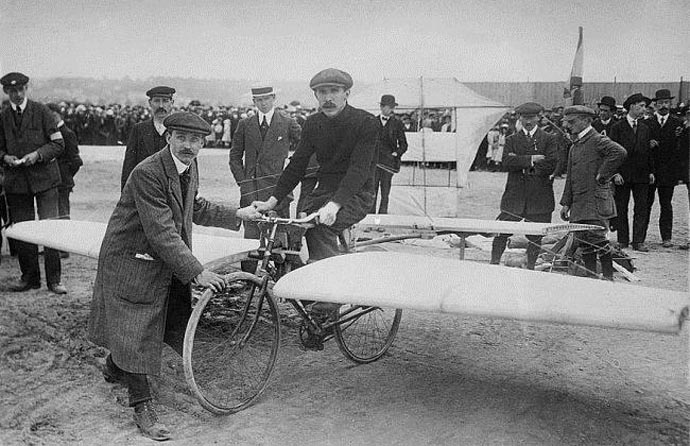The world waited 90 years for a powered flying bicycle, and this summer three turned up at once.
A group of engineers in Czechoslovakia strapped an electric bike to the belly of a quadcopter, a team supported by the ETA launched the folding bicycle-based Paravelo and most recently, and impressively – not least because it’s the only human-powered aircraft in the bunch – a team from America built the Aerovelo; a pedal-powered helicopter.
Cycling and flying
The visceral sensations of freedom and speed experienced by a cyclist are similar to flying. And the way a novice cyclist masters the art of steering by leaning the bike, in a way that quickly becomes instinctive, led the Wright brothers to conclude that flying skills could be acquired in much the same way.
The development of the Wright Flyer owed much to the skills acquired by Wilbur and Orville in the years they had spent as bicycle mechanics.
Less well remembered are the builders of the aviettes – conventional bicycles with canvas wings attached – that were the pioneers of human-powered flight.

In July 1021, The New York Times about French cyclist and aviator Gabriel Poulain, who was a pioneer of the aviette:
“Paris–Gabriel Poulain, the French champion cyclist, succeeded this morning in the Bois de Boulogne in winning the Peugot prize of 10,000 francs for the flight of more than ten meters distance and one meter high in a man-driven airplane. In an ‘aviette,’ which is a bicycle with two wing planes, he four times flew the prescribed distance, his longest flight being more than twelve meters, or about the same number of yards.
Poulain for several years has been devoting himself to the solution of the problem of flight by the power of his own muscles and several times has come near winning a prize. This morning’s exhibition, however, was by far the most successful, a cyclist never before having been able to rise from the ground a sufficient height to enable him to cover more than six or seven meters.
For today’s attempt Poulain altered the angle of the small rear plane of his machine and it was this alteration, it seems, that solved the problem.
Poulain made his attempt just after dawn on the smooth road at the entrance to the Longchamps race course. Several members of the Aero Club, donors of the prize and a large company of journalists and photographers were present. A square twenty meters each away was carefully measured off and chalked so as to mark the points at which the ‘aviette’ must rise one meter from the ground and that two flights must be made in opposite directions.
Poulain, who was confident that this time he was going to succeed, rode his machine at top speed toward the chalked square. As he entered it he released the clutch which throws the wing into proper position and at once the miniature biplane rose from the ground gracefully and steadily to a height of more than a meter.
The flight was as steady as that of a motor-driven airplane and Poulain declared afterward that the motion was smoother than when traveling along the ground. When the judges measured the distance between the wheel marks on the chalk they found it lacked only two centimeters of being twelve meters.
Poulain’s flight in the opposite direction was not quite so successful, though he succeeded in covering eleven and a half meters. In landing he broke two spokes of the rear wheel.
M. Robert Peugeot declared the prize won, but Poulain wished to make further proof of the powers of his machine. After changing the wheel he started from positions chosen by the judges, and in each case he succeeded in covering the prize-winning distance. His longest flight was the last, of twelve meters thirty-two centimetres.
In order to cover so great a distance Poulain worked up to a speed of forty-five kilometres an hour on the ground. According to his own estimate, the muscular force required for flight is equal to three horse power. The total weight of the machine, with the wings, is seventeen kilograms, or about thirty-seven pounds, and the cyclist himself weighs seventy-four kilograms, or about 165 pounds.
After the flight Poulain declared that he intended to set at work at once on another plane, which, he believes, will enable him to fly 200 to 300 meters. On this machine he will make use of a propeller instead of depending, as he did today, simply on impetus.
Once in the air, Poulain says that not so much power is needed as for the take-off. He says the pedal-worked propeller will be strong enough to continue flight for a considerable distance without fatigue.”
0 Comments View now